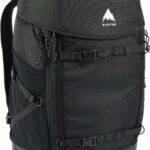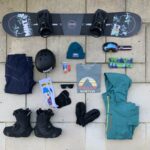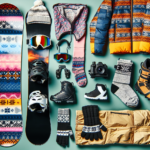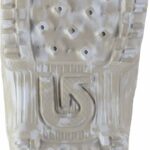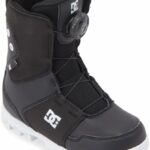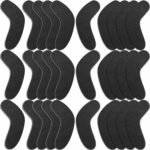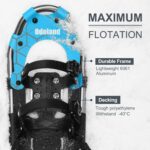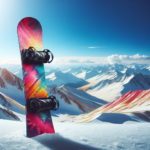So, you’re planning a snowboarding trip? That’s great! Snowboarding is an exhilarating sport that brings a unique mix of adventure and exercise. However, it does require a little bit of preparation. This article will set you up with everything you need to know from what gear you need to pack, to how you should dress, as well as what safety protocols you need to be aware of before hitting those pristine slopes. Get ready because once you’re suited up and start gliding through the snow, there’s no turning back—it’s all about the thrill and enjoyment.
Understanding the Basics of Snowboarding
When it comes to winter sports, snowboarding is one of the most exciting and thrilling. It’s more than just sliding down a snowy hill; it’s a sport that demands skill, balance, and a little bit of bravery.
Familiarizing with snowboarding
Snowboarding involves riding a board sideways downhill on snow. Unlike skiing, where you face forward and have poles to assist you, snowboarding requires you to balance and steer using shifts in body weight. It’s a challenging and stimulating sport that’s sure to give you an adrenaline rush.
Differentiating snowboarding from skiing
You might be wondering how snowboarding differs from its winter sport cousin, skiing. The key difference lies in the equipment and the stance. While skiing requires two separate skis and poles, snowboarding utilizes a single board. The stance in snowboarding is also sideways, while skiing involves a forward-facing stance.
The importance of physical fitness in snowboarding
Snowboarding demands a good deal of physical fitness. Not only does it require strength and endurance, but also flexibility, balance, and coordination. Regular exercise and physical conditioning can help condition your body for the sport and help prevent injuries.
Choosing the Right Snowboarding Gear
One crucial aspect to consider when preparing for snowboarding is choosing the right gear. This includes not just your board, but also bindings, boots, helmets, goggles, and gloves.
Selecting a snowboard
The type of snowboard you choose will generally depend on your specific needs and the type of snowboarding you wish to do. Factors to consider include experience level, riding style, and height.
Importance of quality bindings
Bindings are what connect you to your board. They need to be both comfortable and responsive. High-quality bindings can provide better control and make turning easier, significantly improving your snowboarding experience.
Choosing snowboarding boots
When it comes to boots, fit is everything. They should be comfortable, but snug, as loose or ill-fitting boots can hinder control over your board. Additionally, the flex of your boots should match the flex of your bindings.
Snowboarding helmets and their significance
A helmet is a must-have for any snowboarder, regardless of ability level. It protects your head from potential falls or collisions, effectively reducing the risk of serious head injuries.
Importance of goggles and gloves
Goggles are essential to maintain good visibility on the slopes. They provide protection against the sun, wind, and snow. Similarly, gloves serve to keep your hands warm and dry while also protecting them from potential injuries.
Appropriate Snowboarding Clothing
When snowboarding, what you wear is almost as important as the board under your feet. Appropriate clothing can make the difference between an enjoyable day on the slopes and an uncomfortable one.
Layering clothes
Layering is key when dressing for snowboarding. Choose moisture-wicking base layers to keep sweat away from your skin, insulating mid-layers to trap heat and a waterproof and windproof outer layer to protect against elements.
Choosing the right snowboarding jacket
A good snowboarding jacket is waterproof, insulated, and breathable, promoting warmth and ventilation. It should also be roomy enough to accommodate your layered clothing and provide ease of movement.
Snowboarding pants selection
Snowboarding pants should also be waterproof and insulated. Look for pants with reinforced knees and seat, as these areas endure the most friction.
Importance of thermal socks and accessories
Thermal socks, scarves, neck gaiters, and face masks can make a big difference in your comfort level. These accessories help retain body heat and protect your skin from harsh winter elements.
Importance of Snowboarding Lessons
Whether you are a beginner or looking to improve your skills, snowboarding lessons can be highly beneficial.
Learning basic snowboarding techniques
Snowboarding lessons will teach you essential techniques like initiating turns, stopping, and controlling speed. Mastering these basics is crucial to progressing as a snowboarder.
Understanding safety protocols on the snow
During lessons, you’ll learn about mountain safety protocols such as how to ride a lift, understanding slope markers, and the ‘skier’s code’.
Achieving balance and control
Snowboarding requires a great deal of balance and body control. Lessons can help you develop these skills, improving your overall performance.
Progressing your skills
Even experienced snowboarders can benefit from lessons. New techniques and styles are always emerging, and lessons can help you stay up-to-date and steadily enhance your skills.
Knowing the Suitable Snowboarding Terrain
Choosing the right terrain is essential for a positive snowboarding experience.
Identifying snowboarding areas
Your ability level and comfort factor can help you determine which parts of the mountain are most suitable for you. Beginners might stick to groomed runs, while advanced snowboarders might seek out steeper, ungroomed areas.
Understanding different types of snow conditions
Each type of snow presents a unique challenge. From freshly fallen powder to icy patches, understanding how to navigate different snow conditions can enhance your snowboarding proficiency.
Advantages of going off-piste
For experienced snowboarders, going off-piste can offer an exhilarating experience. It challenges your skills and provides a sense of adventure. However, it should be undertaken with caution and proper preparation due to increased risks.
Learning about snowboarding in different weather conditions
Different weather conditions can significantly impact your experience on the slopes. Snowboarding in snowfall, sunshine, wind, or fog all require different considerations and equipment.
Practising Essential Snowboarding Moves
As with any sport, practice makes perfect in snowboarding too. Constantly practicing and refining your moves can significantly improve your skills and confidence on the board.
J-turns and S-turns
J-turns and S-turns are foundational maneuvers that every snowboarder should master. These involve changing your direction and controlling your speed while maintaining balance.
Learning how to fall properly
Believe it or not, there’s a right way and a wrong way to fall in snowboarding. Learning how to fall safely can help minimize potential injuries and allow you to quickly get back on your feet.
Practicing ollies and nollies
Ollies and nollies are jumps initiated at either the back or front of the board. They are fundamental skills that can be used in various snowboarding styles, including freestyle and backcountry.
Mastering grabs
Grabs involve holding a part of your board in mid-air, adding flair to your jumps. They require significant control and balance but are extremely rewarding once mastered.
Maintaining Your Snowboarding Gear
Maintaining your snowboarding gear can extend its lifespan and enhance your performance on the slope.
Regular cleaning of snowboarding gears
Regularly cleaning your gear can help maintain its functionality, keeping it in optimal condition. This includes wiping down your board and boots after each use and fully drying them out before storage.
Importance of waxing your snowboard
Waxing your snowboard can have a significant impact on your speed and control. It reduces friction between your board and the snow, allowing for a smoother ride.
Checking bindings regularly
A routine check of your bindings for any loose or worn parts can greatly improve safety. This should ideally be done before every ride.
Storage of snowboarding gear
How you store your gear is essential in preserving its condition. Store your gear in a cool, dry place out of direct sunlight and fasten any straps or buckles to maintain shape.
Dealing with Snowboarding Injuries
Even with all necessary precautions, snowboarding injuries can occur. Knowing how to deal with them can speed up recovery and help prevent future injuries.
Preventing common snowboarding injuries
Preventing injuries begins with proper equipment and training. Always ensure your gear is in good condition, and never exceed your skill level.
Knowing first aid measures
Knowing basic first aid measures is essential for any outdoor sport. Mastering how to properly clean wounds, apply bandages, and perform CPR could potentially save a life.
Recognizing the need for professional help
While some minor injuries can be treated independently, major ones always warrant professional medical attention. If you suspect a serious injury such as a fracture, it’s essential that you seek immediate help.
The role of physiotherapy in recovery
Physiotherapy can play an integral role in recovery from a snowboarding injury, helping restore function and strength. It’s often recommended as part of a comprehensive treatment plan.
Staying Safe while Snowboarding
Safe practices are crucial to an enjoyable snowboarding experience.
Snowboarding in a group
Snowboarding in a group is not only more fun but also safer. A friend can call for help during emergencies, assist in navigation, and offer moral support on challenging terrains.
Staying on marked trails
Marked trails and slopes are controlled for safety and specifically designed for snowboarding. Veering off the marked terrain can expose you to dangers like avalanches or other hazards.
Adhering to snowboarding signals
Snowboarding signals alert you to potential obstacles, changes in terrain or conditions, and other safety cues. Understanding and obeying these signals can prevent injury and accidents.
Having emergency contacts
Always have emergency numbers readily available. This could be ski patrol, mountain rescue, or a trusted contact who will know that you are snowboarding and can raise the alarm if needed.
Fitness Conditioning for Snowboarding
Keeping physically fit can significantly enhance your snowboarding experience and prevent injuries.
Importance of overall physical fitness
Your strength, flexibility, balance and cardiovascular fitness all contribute to your performance on the slopes. Staying in good overall shape can help make your snowboarding experience more enjoyable and less strenuous.
Specific exercises for snowboarding
Certain exercises can help condition your body for the demands of snowboarding. Strength training exercises, balance exercises, and flexibility training can all assist in improving your performance and preventing injuries.
The role of flexibility in snowboarding
Flexibility not only aids in performing various snowboarding moves but also reduces your risk of injury. Incorporating stretching into your regular exercise regimen can prevent pulled muscles and promote quicker recovery.
Nutritional advice for snowboarders
Good nutrition is key for endurance and recovery in snowboarding. Consuming a balanced diet rich in protein, carbs, and healthy fats can boost your energy levels and enhance your performance.
Snowboarding is a physically demanding, thrilling, and rewarding sport. Whether you’re a beginner or an experienced pro, correct preparation and understanding can vastly improve your overall experience. So gear up, stay safe, and enjoy the ride!
- What Snowboard Bindings Should I Get? - January 23, 2024
- What Size Screws For Snowboard Bindings? - January 23, 2024
- How To Snowmobile On Water? - January 23, 2024

